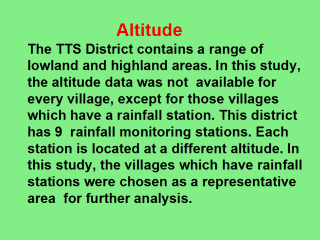| front |1 |2 |3 |4 |5 |6 |7 |8 |9 |10 |11 |12 |13 |14 |15 |16 |17 |18 |19 |20 |21 |22 |23 |24 |review |
 |
Rainfall
In an average year, Timor Tengah Selatan District has 6 months of rainy season and 6 month of dry season. The rainy season goes from November to April and the dry season goes from May to October. Sometimes in May and June, rain still falls but the quantity is less than 10 mm. The excess rainfall normally happens from January to March. The highest median quantity of rainfall for that time was 112 mm to 135 mm. According to median rainfall index, in TTS District, the highest rainfall was in January and February and the dry season started from May to October. In the other two places, the low and high altitude, the rainfall pattern was similar; however the amount of rainfall in the lowland area (Oebello-20 m) was lower than in the highland area (Oelbubuk- 1050m). The greatest amount of rainfall was between December and March. However in 2000, high rainfall still occurred on May. The differential between data from rainfall stations and the median data for the whole for the TTS District occurred due to the variability of rainfall in different altitudes. The rainfall fluctuated by year and by altitude. The rainfall index shows that in low altitudes the quantity of rainfall was less than in high altitudes. However for the areas of 350 m – 1050 m above sea level, there was a variation of the rainfall index. ANOVA One Way test shows that there is a significant difference of rainfall at different altitudes (p=0.028). The area at 800 m, 850 m and 1050 m have a greater rainfall than other areas. The Scatter plot showed that altitude accounted for 66.32 percent of the variability of rainfall in TTS for 1995-2000. There was a strong positive correlation between altitude and rainfall index (r=0.809; p=0.008). |